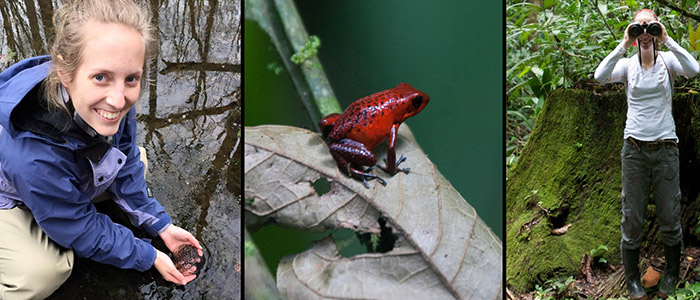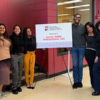ESU Graduate Student Set to Study Frogs in Costa Rica

Posted by: admin on May 14, 2015, 2 Comments
At two-years-old, Laura Beimfohr ’14 picked up a toad and shoved it in her mom’s face. Her mom withheld her scream, put on a smile and said “oh that’s lovely dear.”
“After hearing my mom say the toad was lovely, I thought, frogs are cool — I should like them,” she said.
Beimfohr, a graduate student studying biology from Oxford, Pa., will be spending her summer studying frogs. She recently received a $1,000 Pennsylvania System of Higher Education (PASSHE) grant to help fund her research. Beimfohr applied for the grant, which is specific to graduate students, through ESU’s Foundation website.
Beimfohr will compare tropical and temperate breeding pools in two hemispheres. “Frogs are bio indicators — they indicate the health of the surrounding environment,” she said. “If there are chemicals in any body of water we examine, there will not be any frogs in the water.”
Through this research project, Beimfohr will use contemporary surveying methods to quantify frog and vegetation diversity and determine the type of species that are present in certain habitats. The diversity of frogs will be surveyed using both call identifications and visual encounter surveys. Plant diversity will be quantified by using point-quarter transects, which is a method where a set of points are selected and divided into four 90 degree quadrants, and the plant closest to the point in each quadrant is identified, on both land and aquatic points. This correlation will attempt to answer how temperate and tropical frog breeding communities differ from each other.
Her research kicked off in the beginning of April, starting with temperate locations. Beimfohr stayed in Northeast Pennsylvania. She examined the properties of University Ridge, Stony Acres, and the ESU campus. In these locations, she recorded frog calls, and conducted vegetation and visual encounter surveys. “We’ve already picked up on some possible trends,” she said. “Vegetation between segments that are dry year round, partially submerged or completely submerged in water is distinctly different. Frogs prefer to attach their egg masses to segments submerged completely in water, near the surface, which can be potentially problematic with fluctuating water levels. And lastly, pools with higher conductivity, defined as total dissolved solids, including sodium chloride, seem to have a delayed effect on the development of tadpoles.” Beimfohr added that these are just educated guesses as she has not yet conducted any statistical analysis of temperate data.
She will not be local for much longer.
On May 18, her research will take her to El Zota Biological Station in Costa Rica, where she will continue her study on tropical frogs using the same steps as she did for the temperate frogs.
“This opportunity allows me to experience field research firsthand,” she said. “There is nothing better than that.”
Her travels will conclude on June 28, but that will not mark the end of her project. Set to earn her master’s degree in August 2015, she must complete a research paper, have it published in an academic journal and present her work at the annual meeting of the 2016 Pennsylvania Academy of Science (PAS).
“I won’t see the outside of my room much after I return from Costa Rica,” she said.
The biggest impact of this study is to understand the relationship between a species and their environment, according to Beimfohr.
Lauren Sarnese, a junior majoring in biology from Telford, Pa., Morgan Denner, a senior majoring in environmental studies from Doylestown, Pa., and Kristen Kabat, a junior majoring in conservation biology at Mesa Community College in Arizona, are Beimfohr’s three field assistants. She will also be accompanied by Thomas LaDuke, Ph.D., professor of biology. Dr. LaDuke recently received a PASSHE state grant that allowed him to get his hands on some rattlesnakes. With Beimfohr’s study, he’ll be tackling a whole new animal.
Beimfohr began discussing her project with Dr. LaDuke in Spring 2014, her senior year as an undergraduate at ESU. She quickly decided she would continue her education at the university.
“I fell in love with the small school atmosphere, particularly the exceptional faculty of the biology department, and I knew there was only one logical place for me to attend graduate school,” she said.
Eager to wrap up her graduate studies, Beimfohr plans to pursue her dream of becoming a field biologist for a government or public agency. “I hope to inspire and encourage other young female students to achieve their own dreams in becoming successful scientists,” she said.
Now that Beimfohr has been picking up toads for the past 20 years, her mother doesn’t have to work as hard to withhold her screams. “My mom is extremely supportive of my graduate education and my future career path,” she said.
2 Responses to “ESU Graduate Student Set to Study Frogs in Costa Rica”
Sailor Moore
Posted May 15, 2015 at 6:53 AM
Very Nice!! Miss Beimfohr. I will you well in your adventure!!!
Search
Recent Posts

Julianna and Wayne Bolt Art Contest Winners Selected for the 29th Annual Martin Luther King Jr. Celebration
December 10, 2025 - Read more

ESU Hosts 8th Annual Dr. Barbara G. Collins Social Work Professional Development Day
December 4, 2025 - Read more

ESU Professor Elected to American Society of Plant Biologists Steering Committee
November 25, 2025 - Read more


Angela Braren
Posted May 14, 2015 at 1:34 PM
Laura and her research are an inspiration for budding scientists. She’s raising the last few dollars of her research budget on the crowdfunding platform Instrumentl. Help us get her to Costa Rica! https://www.instrumentl.com/campaigns/laurabeimfohr